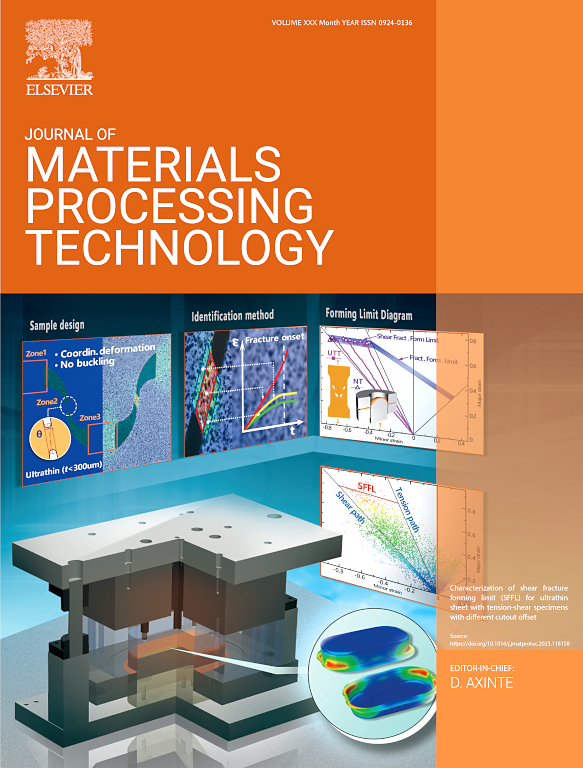航空航天薄壁件的无颤振铣削
IF 6.7
2区 材料科学
Q1 ENGINEERING, INDUSTRIAL
Journal of Materials Processing Technology
Pub Date : 2025-05-14
DOI:10.1016/j.jmatprotec.2025.118903
引用次数: 0
摘要
航空航天薄壁件的铣削加工对几何精度和表面质量的要求极高,这些因素对飞机的性能和运行可靠性有重要影响。铣削颤振不仅严重损害加工表面的完整性,加速刀具磨损,还会导致灾难性的生产故障和重大的经济损失。近几十年来,加工界一直致力于研究铣削颤振机理和开发相应的控制策略。在颤振稳定性预测、在线状态监测和主动/被动抑制技术方面取得了显著进展,最终目标是实现无颤振铣削作业。然而,与传统铣削工艺相比,薄壁零件加工由于其固有的特点,如结构刚度低、可加工性差以及铣削过程中涉及的复杂动力学(包括时变行为、模态耦合和位置依赖效应),提出了独特的挑战。这些综合因素对颤振的有效控制构成了重大障碍。因此,本文集中讨论了航空航天薄壁零件铣削颤振研究的最新进展:(i)通过结合力致变形和刀具磨损效应,建立准确表征实际铣削过程的动力学模型;将动态参数更新技术与概率稳定性叶瓣图(SLD)求解方法相结合,提供具有风险意识的颤振预测结果。(ii)利用多信号融合和统计分析/人工智能(AI)实现颤振状态实时监测;探索在有限样本量和可变操作条件下提高监测模型泛化能力的有效措施。(iii)系统评估被动和主动颤振抑制策略,结合数字孪生技术,实现颤振监测、抑制和流程优化的无缝集成。(iv)讨论铣削颤振引起的零件表面/亚表面缺陷,并使用相关指标量化颤振痕迹对表面完整性的影响。通过对前沿研究和工业应用的批判性分析,我们进一步评估了当前研究的局限性,并提出了有希望的未来方向。这些创新包括颤振机制建模、不确定性量化、物理-人工智能混合方法、边缘云雾监测系统、新材料开发、支持元数据的人机界面以及形状精度-表面完整性的协同控制技术。本文章由计算机程序翻译,如有差异,请以英文原文为准。
Chatter-free milling of aerospace thin-walled parts
The milling process of aerospace thin-walled parts requires extremely high geometric precision and surface quality, as these factors significantly influence aircraft performance and operational reliability. Milling chatter not only severely compromises machined surface integrity and accelerates tool wear, but also induces catastrophic production failures and significant economic losses. Over recent decades, the machining community has dedicated substantial efforts to investigating milling chatter mechanisms and developing corresponding control strategies. Remarkable progress has been made in terms of chatter stability prediction, online condition monitoring, and active/passive suppression techniques, with the ultimate objective of achieving chatter-free milling operations. However, compared with conventional milling processes,
thin-walled part machining presents distinctive challenges due to their inherent characteristics such as low structural rigidity, poor machinability, and complex dynamics involved during milling operations (including time-varying behaviors, modal coupling, and position-dependent effects). These combined factors pose significant obstacles to effective chatter control. This paper consequently concentrates on recent advancements in milling chatter research for aerospace thin-walled parts: (i) Establishing dynamic models that accurately characterize actual milling processes by incorporating force-induced deformation and tool wear effects; integrating dynamic parameter updating techniques with probabilistic stability lobe diagram (SLD) solution approaches to provide risk-aware chatter prediction results. (ii) Leveraging multi-signal fusion and statistical analysis/artificial intelligence (AI) to realize real-time chatter condition monitoring; exploring effective measures to improve monitoring model generalization capabilities under limited sample sizes and variable operational conditions. (iii) Evaluating passive and active chatter suppression strategies systematically, combined with digital twin technology to enable seamless integration of chatter monitoring, suppression, and process optimization. (iv) Discussing milling chatter-induced part surface/sub-surface defects, with related indexes to quantify the effect of chatter marks on surface integrity. Through critical analysis of cutting-edge research and industrial applications, we further evaluate current research limitations and present promising future directions. These include innovations in chatter mechanism modeling, uncertainty quantification, physics-AI hybrid methodologies, edge-cloud-fog monitoring systems, novel materials development, metaverse-enabled human-computer interfaces, and collaborative control technologies of shape accuracy-surface integrity.
求助全文
通过发布文献求助,成功后即可免费获取论文全文。
去求助
来源期刊

Journal of Materials Processing Technology
工程技术-材料科学:综合
CiteScore
12.60
自引率
4.80%
发文量
403
审稿时长
29 days
期刊介绍:
The Journal of Materials Processing Technology covers the processing techniques used in manufacturing components from metals and other materials. The journal aims to publish full research papers of original, significant and rigorous work and so to contribute to increased production efficiency and improved component performance.
Areas of interest to the journal include:
• Casting, forming and machining
• Additive processing and joining technologies
• The evolution of material properties under the specific conditions met in manufacturing processes
• Surface engineering when it relates specifically to a manufacturing process
• Design and behavior of equipment and tools.
 求助内容:
求助内容: 应助结果提醒方式:
应助结果提醒方式:


